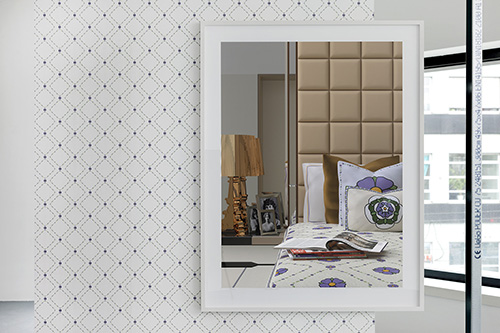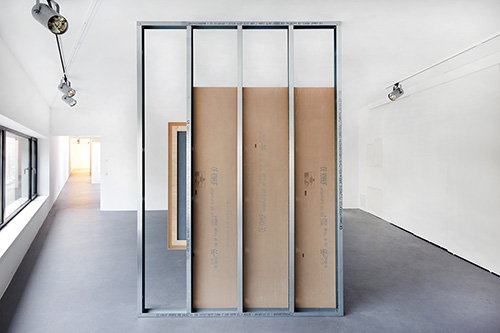[2018] A New Room of One's Own (The Fourth Wave)
Aluminum drywall construction, wallpaper, framed computer-generated image
290 x 200 x 9 cm
Developed as a sequel to Life as Art Form (2015) and referring to Virginia Woolf's groundbreaking essay on feminist literary criticism, the series A New Room of One’s Own engages in the architectural discourse around "Emerging Realities” as critical concept and practice. Drawing on current architectural 3D visualization practices, it combines a critical analysis of the production of images for global real estate advertising portfolios (and their nostalgia for outmoded common values) with the history of women's rights movements.
Large-format computer-generated images of interiors are integrated into specifically designed, unfinished sculptural drywall displays that refer to the architectural setting of the exhibition space—a site originally conceived of as a luxury apartment. They include references to respective historical and contemporary feminist literature, journals, texts, and theories, as well as feminist icons such as political activists and artists. These interventions tackle and unsettle the smooth aesthetics of the images, undermining the conventional patterned representations of the real estate industry, with their ingrained social values. At the same time, the radical motifs and symbols—taken from historic feminist movements and transferred into industrial patterns of the wallpaper or pillows—refer to current debates around issues of mainstream feminism and the commodification of the feminist discourse.
"[…] What appears in the outlines of these constructed and imaginary images is the projection of a future lifestyle assembled through visual codes and simulacra. The rendered images refer to a given visual structure reminiscent of photographic reality. Materials and surfaces are the main actors in these prints, seen visually, as abstract signs. The wallpaper—the printed version of what is seen in these images—creates a material anchor to these ungraspable images. Only by situating the prints on physical displays in the exhibition space, revealing the rear-side of these constructed walls of aluminum, particle board, and paint, do they situate themselves in a model-like, speculative architectural context […]" - Lilian Haberer
< Index



